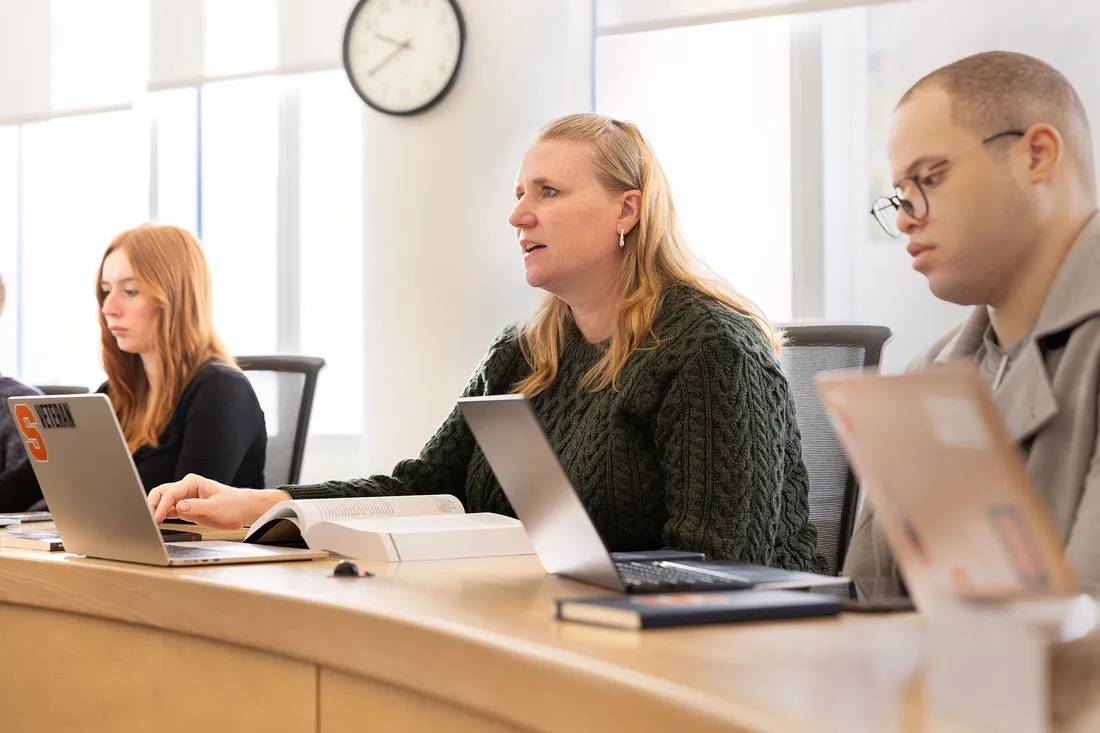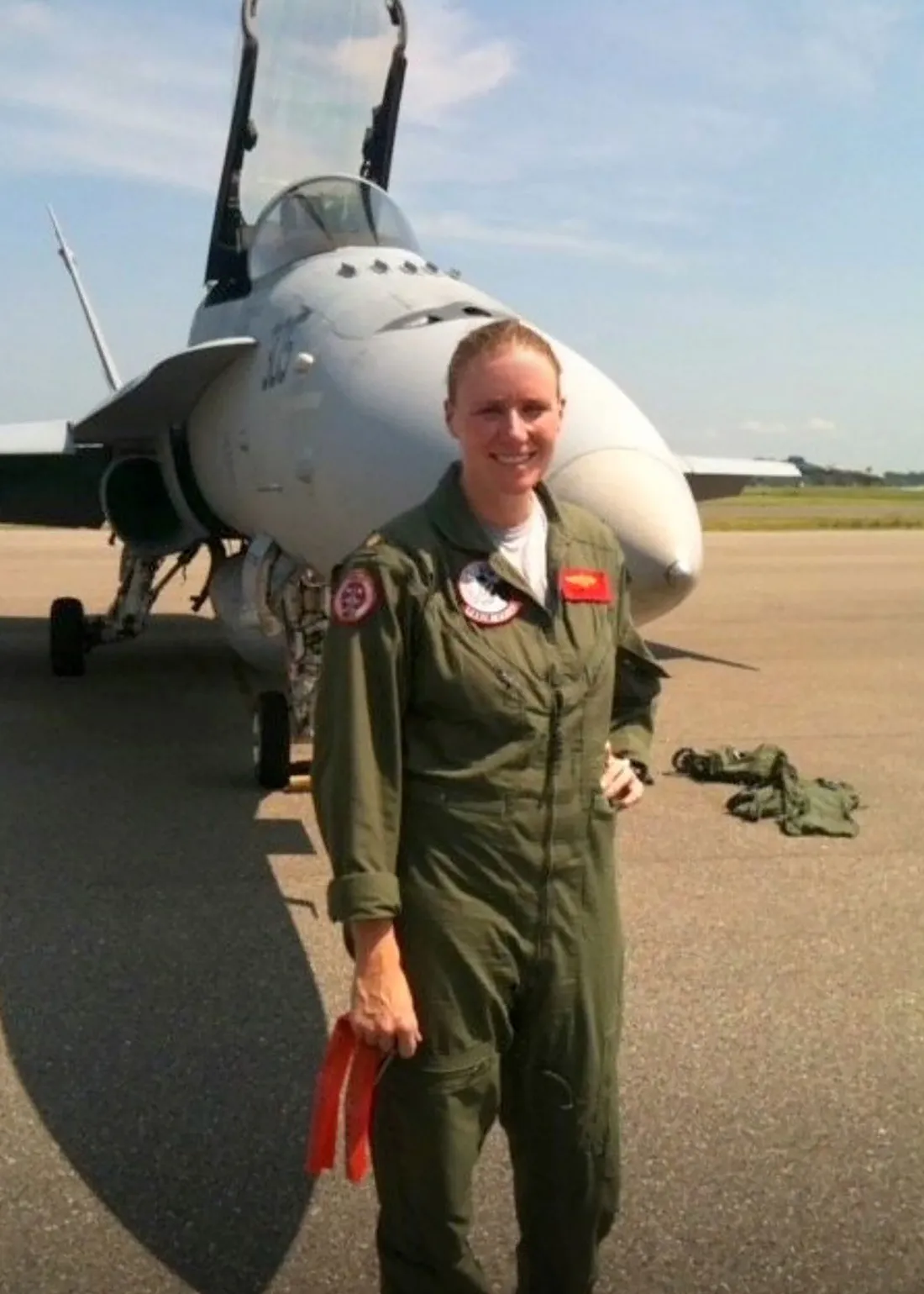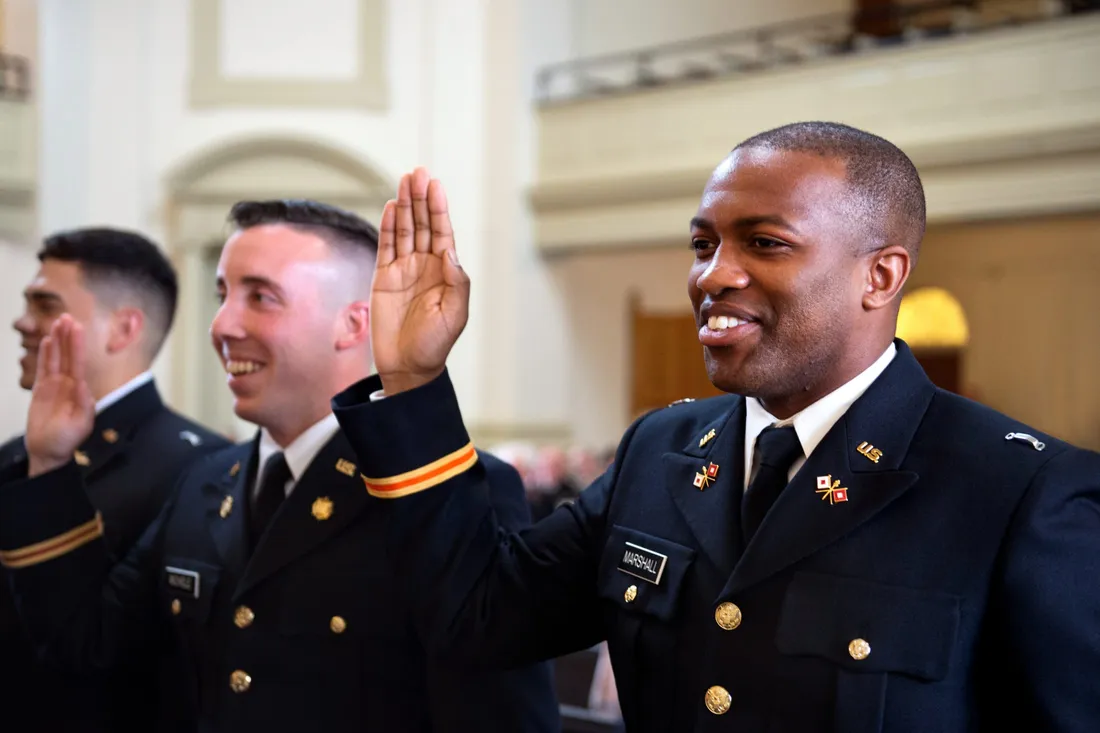Any mention of the 2022 blockbuster Top Gun: Maverick brings a smile to the face of Laurie Coffey L’25, a second-year student at the Syracuse University College of Law. “I used to fly many of the routes in the movie,” says the retired U.S. Navy aviator. “Tom Cruise’s stunt pilot is a former Blue Angel, whom I’ve known for years. We went to flight school together.”

Retired Navy Lt. Cmdr. Laurie Coffey L’25 is a second-year law student with an interest in legal advocacy.
While Coffey’s military career is behind her, it still colors everything she does—from being a single parent to a full-time law student. “The Navy remains an important part of my life,” admits Coffey, who retired in 2019 as a highly decorated lieutenant commander. “It’s who I am.”
Numbers tell part of the story. Over a 20-year span, Coffey amassed more than 25 combat missions, 100 combat hours, 2,400 flight hours and 300 carrier landings (half of which were at night). She also was featured in the Emmy Award-winning PBS documentary Carrier, while deployed on USS Nimitz during Operation Iraqi Freedom.
Trained on the coveted F/A-18 Hornet and Super Hornet, Coffey is Top Gun royalty. Ironic, considering that the term doesn’t stand for anything. “It’s a nickname for a naval aviation training program,” says Coffey, the recipient of a prestigious Air Medal for “heroic or meritorious achievement.”
What Hollywood rarely captures is all the training that goes into each flight. Coffey, who regularly flew six-hour missions, recalls that for every hour of flying there were four hours of planning and preparation. Each mission was then followed by a two-hour “debrief,” where the pilot analyzed anything that went wrong or not as planned.
“It’s exacting work,” admits the former flight instructor at Naval Air Station Oceana in Virginia Beach. “Because it’s impossible to know all there is about combat flying, you’re always training. You never truly arrive.”
From Classroom to Courtroom

Coffey credits Syracuse University’s Office of Veteran and Military Affairs and the D’Aniello Institute for Veterans and Military Families for helping her make the transition from military to civilian life. “Syracuse’s commitment to veterans is why I’m here,” says the former combat pilot.
Of all the missions she’s carried out, Coffey is most excited about her current one at Syracuse. An interest in local politics inspired her return to the Empire State after a 30-year absence. “Central New York is one of the prettiest places in the world,” gushes the Skaneateles resident. “The Syracuse campus embodies all that’s great about the region and its people.”
While she hasn’t declared a specialization, Coffey is leaning toward Syracuse Law’s nationally ranked Advocacy Program, which trains litigators—lawyers who take cases through the court process. Her military background is a bonus, as evidenced by a recent, three-month internship at Manhattan-based Fitzpatrick, Hunt and Pagano, where she served on the firm’s aviation and aerospace legal team.
On campus, Coffey gains additional experience through the Betty and Michael D. Wohl Veterans Legal Clinic, representing veterans and their families seeking benefits from the U.S. Department of Veterans Affairs or military discharge upgrades. She’s one of only two second-year students currently arguing a case before a Veterans Law Judge (VLJ) on the Board of Veterans’ Appeals. “It’s kind of a big deal,” says Coffey, adding that VLJs preside over hearings of administrative disputes in the federal government. “The clinic helps me put theory into practice.”
She also participates in the Central New York Women’s Bar Association and the student chapter of the Animal Legal Defense Fund.

Coffey gains hands-on, real-world experience through her involvement with the Betty and Michael D. Wohl Veterans Legal Clinic.
The holder of bachelor’s and master’s degrees from the U.S. Naval Academy and the U.S. Naval War College, respectively, Coffey is excited about her initial foray into civilian postsecondary education. She credits Syracuse University’s Office of Veteran and Military Affairs and the D’Aniello Institute for Veterans and Military Families for helping her navigate the transition.
“Syracuse’s enduring commitment to veteran and military-connected families is why I’m here,” says Coffey, who previously was a logistics manager for Amazon U.K. in London. “Even though I’m older than most student veterans, I feel like I belong here. I’m with my people.”
Granted, veterans are becoming a powerful minority on U.S. campuses. At Syracuse, the thousand-member veteran and military-connected community has grown more than 60% in the past decade. “Veterans bring a unique perspective to the classroom,” Coffey observes. “We’re no longer considered an oddity or a curiosity. We’re an asset to almost any academic conversation.”
Soaring to Success
Growing up in Corning, New York, Coffey originally wanted to be an astronaut. But it was her talent for basketball, lacrosse and rowing that helped her push the envelope on gender roles and expectations. A pivotal moment occurred in high school, where the 6-foot-1 Coffey was the first woman to try out for—and make—the J.V. boys’ lacrosse team. “I came from a family of athletes,” she says, adding that her father and younger sister were Olympic rowers. “I didn’t know anything different.”

Coffey and her F/A-18 Hornet take a break in Baton Rogue, Louisiana, during a cross-country flight. She amassed more than 2,400 flight hours and 300 carrier landings during her 20 years in the Navy.
Coffey’s fascination with sport continued at Phillips Academy (aka Andover), an elite boarding school in Massachusetts, and the Naval Academy in Annapolis, Maryland. After graduation, she delayed military service and trained for the 2000 Summer Olympics with USRowing’s senior national team. Coffey also was invited to compete for a spot on three different WNBA franchises. One of them was the now-defunct Miami Sol, where she suffered a career-ending Achilles tear during a tryout in 2000.
With Olympic and WNBA dreams dashed, Coffey reported to flight school. It was a bold move, considering that women weren’t permitted to fly combat missions until 1993. “Today, women account for less than 1% of all Navy fighter pilots,” she says. “We’re a small, tightknit community.”
Coffey, whose call sign was “Mocha,” skyrocketed to success, smashing the sound barrier and the glass ceiling. She also befriended some fascinating people along the way, like musician Jimmy Buffett, a fellow sailor and private pilot. “He used to go sailing with us when I worked at the Naval Academy,” Coffey remembers. “Super-friendly, down-to-earth guy.”
Coffey reserves her highest praise for her 14-year-old daughter, Brooke, who plays football and ice hockey. A chip off the old block? Perhaps. “I drive a school bus part time just so I can see her,” says the self-avowed “hockey team chauffeur.” “The Navy taught me a lot, including how to be a good student and, more importantly, a better person.”


